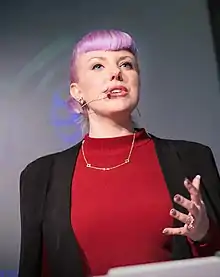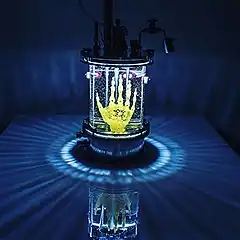Amy Karle
Amy Karle (born 1980) is an American artist, bioartist, and futurist whose work focuses on the relationship between technology and humanity, specifically how technology and biotechnology impact health, humanity, society, evolution, and the future.[1][2][3][4][5] Karle combines science and technology with art and is known for using living tissue in her work.[6][7][8]
Amy Karle | |
|---|---|
 Amy Karle in 2019 | |
| Born | 1980 (age 42–43) New York, U.S. |
| Nationality | American |
| Notable work | Regenerative Reliquary, Internal Collection, Heart of Evolution?, Biofeedback, Cyborg Couture |
| Movement | Ultra-contemporary art, contemporary art, conceptual art, new media art, bioart, hybrid arts, digital art, computational art, performance art |
| Website | www |
Karle has served as an Artist Diplomat through the United States Department of State Bureau of Educational and Cultural Affairs, where she led workshops focusing on women's empowerment in STEAM fields.[9][10] In 2019, she was named one of the BBC's 100 women.[11]
Personal life
Karle was born in New York in 1980[12] and grew up in Endicott, NY. Her mother was a biochemist and her father was a pharmacist and Karle has said she "grew up in the lab and in the pharmacy".[13] Karle is an alumnus of the School of Art and Design at Alfred University and Cornell University where she received degrees in Art and Design and Philosophy.[14][15]
Karle was born with a rare condition, aplasia cutis congenita, missing a large region of skin on her scalp and also missing bone in her skull. She underwent a series of experimental surgical procedures as a child. The skin was repaired by tissue expansion surgery that was considered dangerous and experimental at the time that it was performed.[16][13] This experience impacted her work and desire to heal and enhance the human body and human condition.[17] This early experience also inspired her interest in the links between biology, medical futuring and art.[11][7]
Work

Karle researches and explores the impact of technology on bodily enhancement through her artwork.[8][18][2]
Her sculpture, Regenerative Reliquary (2016) features a 3D-printed bioprinted hydrogel scaffold shaped like the bones of a human hand placed inside a glass vessel. Human Mesenchymal stem cells from a living donor were placed on the scaffold which over time grew into bone.[8][19][20][21][22] It has been exhibited internationally.[23][24][25][26][27]
Karle has created a number of artworks and performances using biofeedback and neurofeedback including:[28] A work from 2011, Biofeedback Art, was a durational performance where Karle's body was connected to a Sandin Image Processor that detected the changes that occur while she meditated over periods of 5–8 hours. Video art was created in the form of projections during the process.[29][18][30] In 2015, Brainsongs involved connecting her brain activity via an EEG neuroheadset to musical instruments in a digital interface to output music.[31] In the same year, Resonation involved an EEG neuroheadset connected to a Chladni plate to generate bio-signals into visuals and sounds. Her 2018 Performance in Salt Mine was conducted in the Bochnia Salt Mine and Wieliczka Salt Mine using an EEG neuroheadset to translate her brainwaves into digital music and projected visualizations, which were later used in a planetarium film she made. [32][33][28][34]
Internal Collection (2016–17) is a series of garments based on human anatomy. The fabrication consists of 3D body scanning, computer-aided design, laser cutting, and hand-sewing techniques to create representations of internal body systems.[35][36][37]
Cyborg Fashion (2022-2023) is a digital art and fashion collection where Karle envisions "biofashion in a post-natural world when bodies and beings are altered by biotechnology".[38][39]
The Body and Technology: A Conversational Metamorphosis (2017) is a collection of 2D artworks by Amy Karle made by hand and with artificial neural networking, machine learning, and artificial intelligence. In this body of work, Karle coupled artificial intelligence in healthcare with generative design to devise a system for leveraging AI in the diagnosis of disease, with generative CAD designing replacement parts, and 3D bioprinting to create implants.[40][41]
Morphologies of Resurrection (2020) is a series of 6 sculptures created as part of a Smithsonian residency.[42] Karle's process examined the possibilities of reconstructive technologies and future evolution through biotechnological advancements.[43][44] The artworks are novel evolutionary forms based upon extinct species to explore “hypothetical evolutions through technological regeneration”, 3D printed in biocompatible material.[45] [46] They were exhibited at the Smithsonian Institution.[47]
Karle was mentioned in 2019 as one of the BBC's 100 women.[11]
Digital art
The majority of Karle’s works include digital technologies and digital processes. Karle has also worked in decentralized computing and blockchain for biology and genetics and was an early adaptor of NFT technology.[48][49] Karle stated: "I see decentralization as a vehicle to transcend the physical limitations of what art - and our lives - can be."[50] The Skull Collection (2021–22), is a series of NFT artworks by Karle that “are contemplations of how we can transcend the physical into the digital after we die.”[51][18]
Artificial Intelligence (AI)
Karle has spoken on AI and biology.[6][52][53] Karle has integrated AI, artificial neural networking, machine learning, and 3D generative design and engineering into her practice for creative purposes and to explore their implications on healthcare and the future.[54][39] Her AI and bio-AI hybrid artworks have been in museum exhibitions including: Artificial Intelligence: AI / The Other I Ars Electronica Linz, Austria,[23] La Fabrique Du Vivant Centre Pompidou, Paris, France,[55][25] and Future and the Arts: How Humanity Will Live Tomorrow Mori Art Museum, Tokyo, Japan.[12][56][57][52][53]
References
- "'How I create art with human cells'". BBC News.
- Schnugg, Claudia (28 February 2019). "Creating ArtScience Collaboration: Bringing Value to Organizations". Springer.
- U.S. Department of State. "American Arts Incubator Exchange Artist Amy Karle". American Arts Incubator, initiative of the U.S. Department of State's Bureau of Educational and Cultural Affairs developed in partnership with ZERO1.
- Han, Gregory (6 April 2020). "Futurist Amy Karle Unlocks the Potential of Humanity's Future". Design Milk. Retrieved 23 August 2023.
- Elwell, J. Sage (3 December 2020). "Religion and the Digital Arts". Religion and the Digital Arts. Brill. pp. 1–109.
- Stocker, Gerfried; Schöpf, Christine; Leopoldseder, Hannes, eds. (2017). "AI Artificial Intelligence - Das andere Ich" (PDF). Ars Electronica. p. 392.
- "The woman creating art with human stem cells". BBC News. 7 March 2020. Retrieved 6 March 2021.
- Elwell, Sage (7 December 2020). Religion and the Digital Arts. Brill Publishers. ISBN 978-90-04-44759-2.
- "American Artist and Copernicus Science Center Launch First Arts Incubator Program in Poland". Pl.usembassy.gov. 2 May 2018.
- "Spis treści. Na okładce: Eksponat Chmury, dotyczący zmian klimatu, wystawa RE: Generacja. - PDF Free Download". Docplayer.pl.
- "BBC 100 Women 2019: Who is on the list this year?". BBC News. 16 October 2019. Retrieved 6 March 2021.
- "Future and the Arts exhibition: How humanity will live tomorrow" (PDF). Mori Art Museum. Mori Arts Centre. March 2020. Retrieved 2 April 2021.
- Mendoza, Hannah Rose (27 November 2017). "3D Printing Spotlight On: Amy Karle, Award Winning BioArtist". 3DPrint.com | The Voice of 3D Printing / Additive Manufacturing. Retrieved 6 March 2021.
- "Amy Karle | American Arts Incubator". Retrieved 15 February 2022.
- "Alumni selected for Ars Electronica .ART Global Gallery – Expanded Media". Alfred University. 12 September 2020. Retrieved 15 February 2022.
- "Regenerating the human body with art: Amy Karle's bio-artistic proposal". Fahrenheit Magazine. 5 February 2021. Retrieved 6 March 2021.
- "'How I create art with human cells'". BBC News.
- Bart, Marlene; Breuer, Johannes; Freier, Alex Leo (2022). Atlas of Data Bodies 1: Body images in art, design and science in the age of digital media.Imagining Life: Amy Karle's Artistic Research Practice. pp. 22–33. ISBN 978-3-8376-6178-1.
- Callaghan, Meaghan Lee (12 October 2016). "An Artist Is Growing A Skeleton Human Hand In A Lab". Popular Science. Retrieved 12 August 2023.
- Pangburn, D. J. (6 July 2016). "This Artist Is Biohacking The Body To 3D-Print Fantastical Human Bones". Fast Company. Retrieved 31 March 2021.
- "Artist Amy Karle is growing a human hand with 3D printed scaffolds and stem cells". 3ders.org. Retrieved 10 December 2021.
- "Awareness in physical and mental changes in the bioart of Roy Ascott". Fahrenheit Magazine. 17 February 2021. Retrieved 21 June 2023.
- "Ars Electronica Archiv". Archive.aec.at. Retrieved 10 December 2021.
- Sina Contemporary Art (8 September 2018). "新浪当代艺术丨【干货】第二届北京媒体艺术双年展(BMAB)论坛 [The 2nd Beijing Media Art Biennale (BMAB) Forum]". Weixin Official Accounts Platform (Contemporary Art Channel). Retrieved 31 March 2021.
- "Design: Expo "La Fabrique du vivant", le biodesign au Centre Pompidou". Paris-art.com. 17 March 2019.
- "Exhibition Insight: 'La fabrique du Vivant', Centre Pompidou Paris". CLOT magazine. 18 February 2019. Retrieved 31 March 2021.
- ArtFacts. "Amy Karle | Artist". ArtFacts. Retrieved 12 August 2023.
- Twardoch-Raś, Ewelina (10 December 2019). "Pętle neurofeedbacku : elektroencefalografia jako strategia artystyczna w wybranych projektach z zakresu art & science". Kultura Współczesna. 4 (107). doi:10.26112/kw.2019.107.11. Retrieved 10 December 2021.
- "Birth". Durationalperformance.biofeedback.art. Retrieved 10 December 2021.
- Zhang Haitao. "未来媒体艺术 艺术档案 (Controversy and Challenges: Future Metaverse Art)". www.artda.cn. Retrieved 8 January 2022.
- Marlene Bart and Johannes Breuer. Atlas of Data Bodies: Body images in art, design and science in the age of digital media. Bauhaus.
- Karle, Amy. "What is Life in the Bio-Tech Era? Creating a More Resilient Future". Americanartsincubator.org. Retrieved 10 December 2021.
- "Arts Incubator Program Successfully Concludes with Exhibition at Copernicus Science Center". Pl.usembassy.gov. 21 May 2018. Retrieved 10 December 2021.
- "台北當代藝術館《蓋婭:基因、演算、智能設計與自動機 幻我;它境》14位國內外藝術家展現藝術與科技的碰撞展演,腦洞大開新體驗 首件展覽衍生性NFT作品2月19日上線發行". 非池中藝術網. Retrieved 22 September 2023.
- Nair, Shraddha (21 December 2019). "The future through art at Mori Art Museum, Tokyo". StirWorld.com. Retrieved 22 July 2021.
- "FILE FESTIVAL". file.org.br. Retrieved 21 June 2023.
- Twardoch-Raś, Ewelina (2 November 2021). Sztuka biometryczna w perspektywie filozofii post- i transhumanizmu: w stronę estetyki postafektywnej (in Polish). Wydawnictwo UJ. ISBN 978-83-233-7212-7.
- "The Influential: Robot Couture – Is Tech Fashion Having a Moment?". Retrieved 22 June 2023.
- Campbell, Clayton. "A Short Walk Through the Uncanny Valley of A.I. Art". Artblog. Retrieved 22 July 2023.
- "Amy Karle BioArtist". ideaxme. Retrieved 30 March 2021.
- "Ars Electronica X .art Domains - the Digital Launch You Don't Want to Miss". .ART. 9 September 2020. Retrieved 31 March 2021.
- "Morphologies of Resurrection | Unreal — Science Gallery Rotterdam". unrealexhibition.com. Retrieved 6 March 2021.
- "Open Access Remix". Smithsonian Institution. Retrieved 10 December 2021.
- "21st-Century Diffusion with Smithsonian Open Access". Smithsonian Institution. Retrieved 10 December 2021.
- "Futurist Amy Karle Unlocks the Potential of Humanity's Future". Design-milk.com. 6 April 2020. Retrieved 10 December 2021.
- "Khronos and Smithsonian collaborate to distribute content". Gfxspeak.com. 28 February 2020. Retrieved 10 December 2021.
- "Smithsonian Releases 2.8 Million Images Into Public Domain". Smithsonian Magazine. Retrieved 10 December 2021.
- "艾厂× aai | 生成式和自治的艺术:对版权法有什么影响?(Generative and Autonomous Art: How Does It Affect Copyright Law?) by Ai Chang × aai".
- Zhang Haitao. "西方生物艺术简史(1933-2018)——新伦理艺术运动(下) A Brief History of Western Bio-Art (1933-2018) - The New Ethical Art Movement (Part 2)". Art Archives Network. Retrieved 1 August 2019.
- "NgraphT by Keevo Partners with Artist Amy Karle to Drop First NFT Art Collection". Yahoo! Finance. Retrieved 18 February 2022.
- "SubnetTALK | Amy Karle - FS1". FS1. 13 January 2022.
- Tournay, Virginie (31 March 2020). L'intelligence artificielle. Les enjeux politiques de l'amélioration des capacités humaines (in French). Editions Ellipses. ISBN 978-2-340-04296-4.
- "Voyage au cœur de l'IA: derniers jours en kiosque". Libération (in French). Retrieved 12 August 2023.
- "Amy Karle | Metal Magazine". metalmagazine.eu. Retrieved 11 August 2023.
- "La Fabrique Du Vivant" (PDF). Culture.gouv.fr. Retrieved 10 December 2021.
- "Future and the Arts: AI, Robotics, Cities, Life - How Humanity Will Live Tomorrow". Mori.art.museum.
- Joffrin, Laurent (28 November 2018). "A new special issue: AI, at the heart of the human". LIBERATION. Retrieved 22 June 2023 – via amykarle.com.